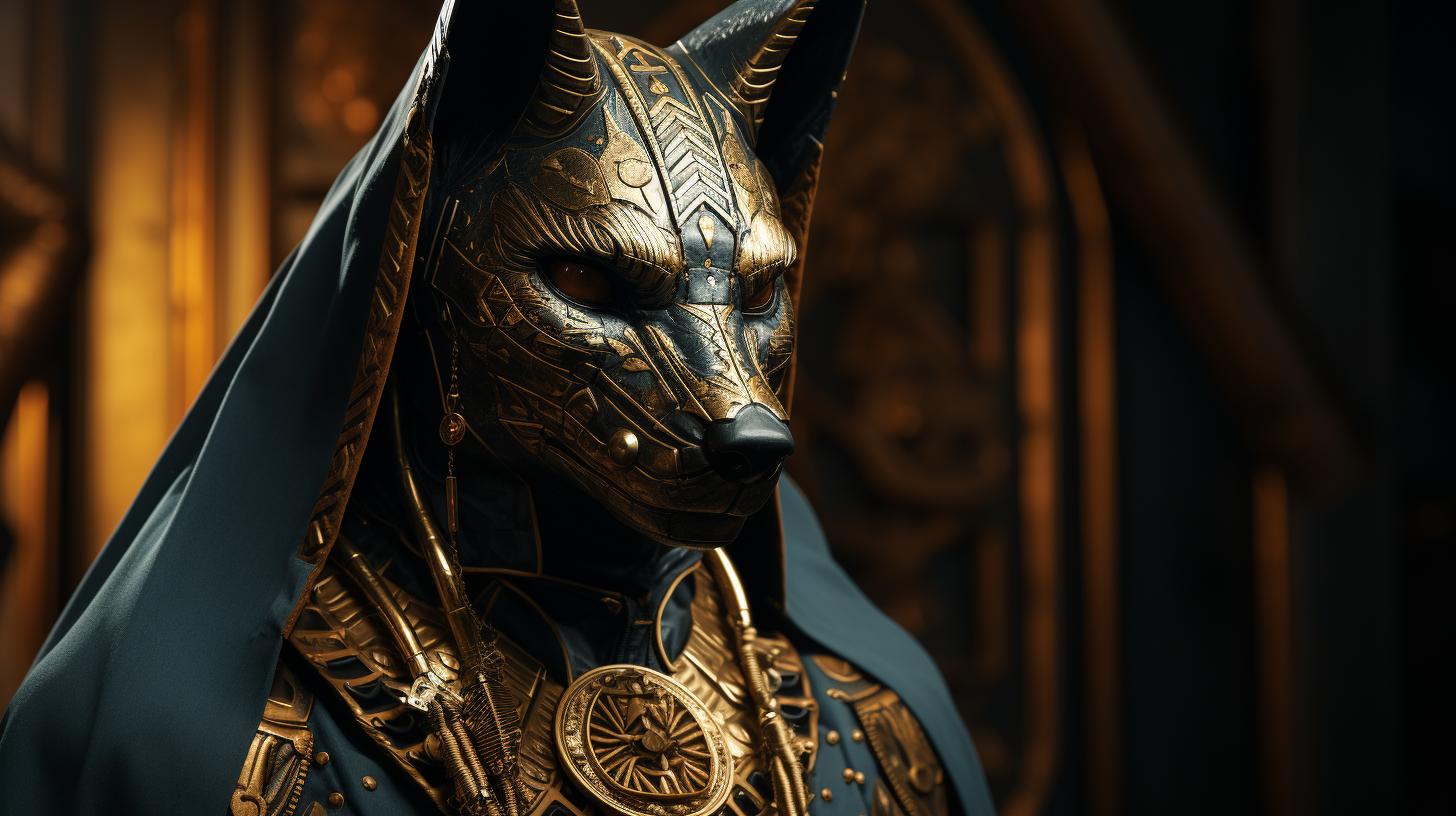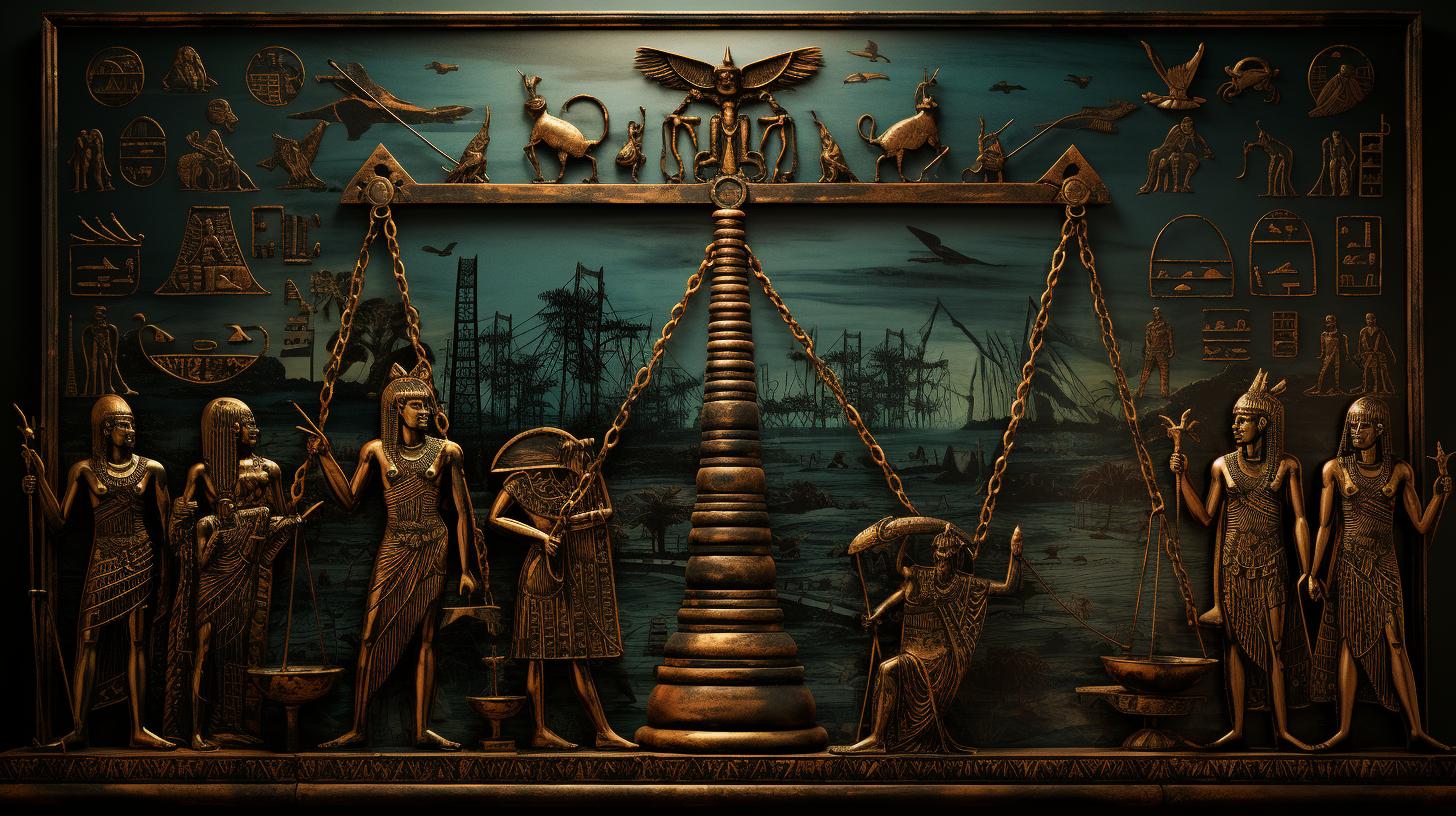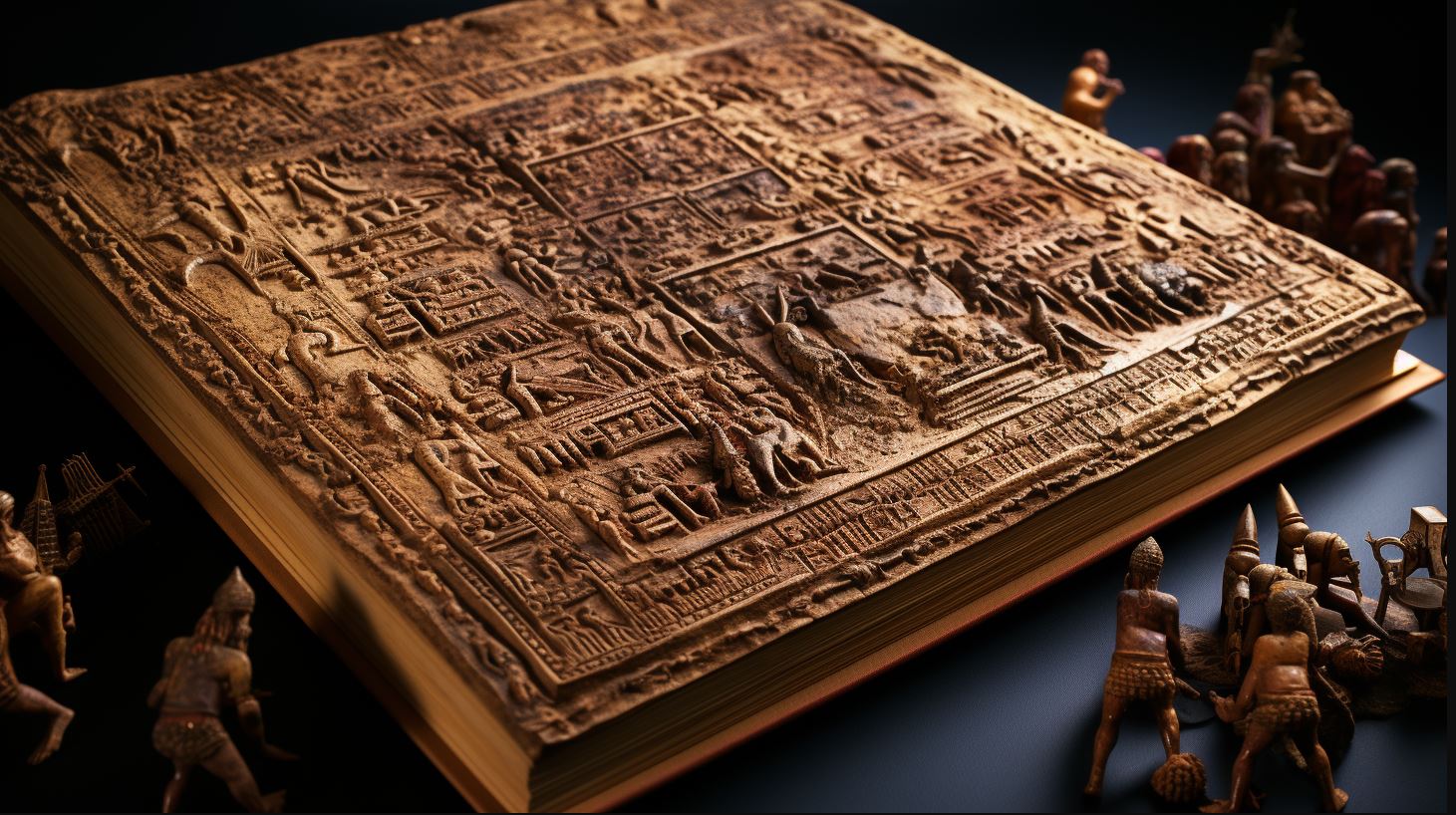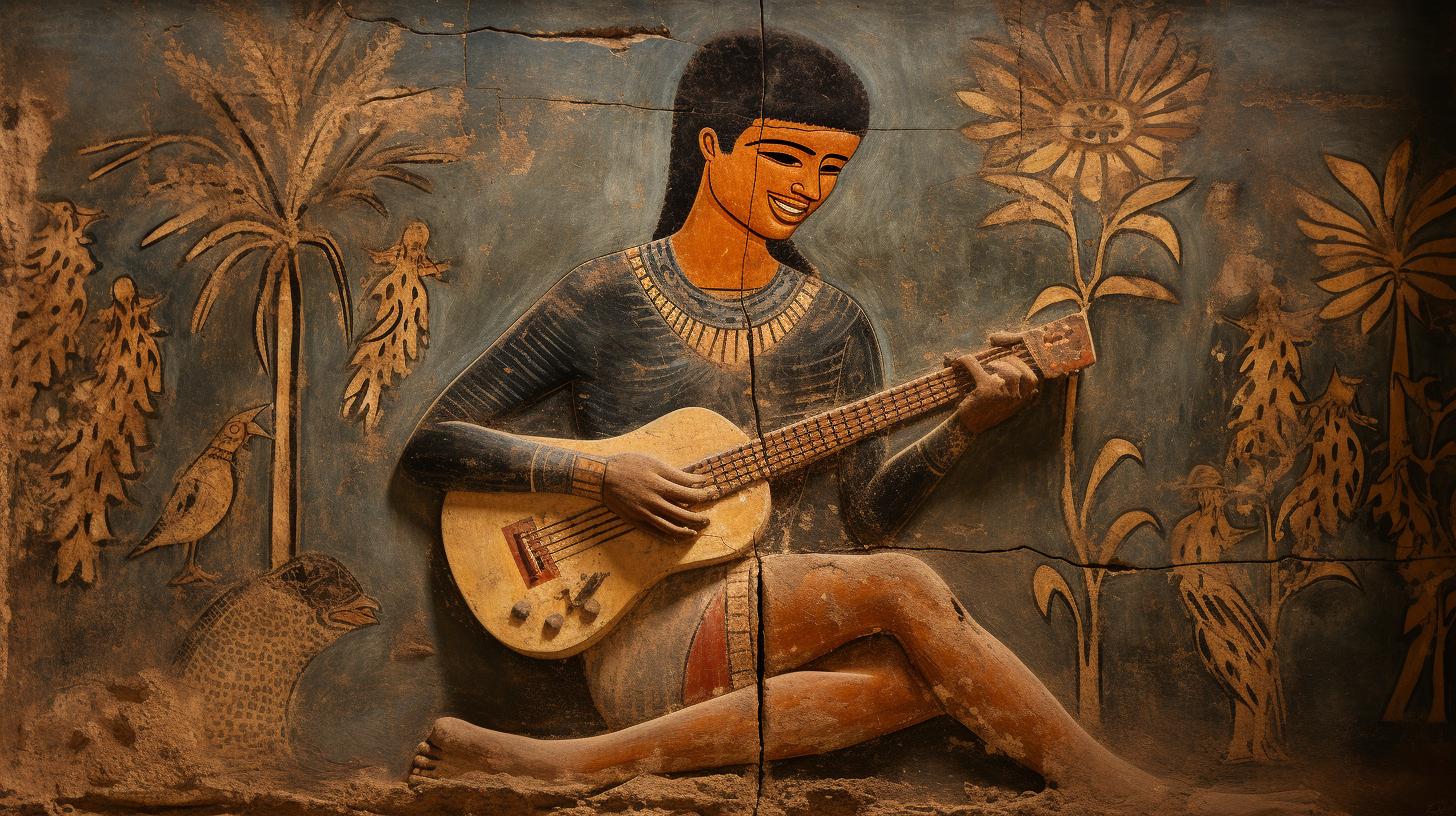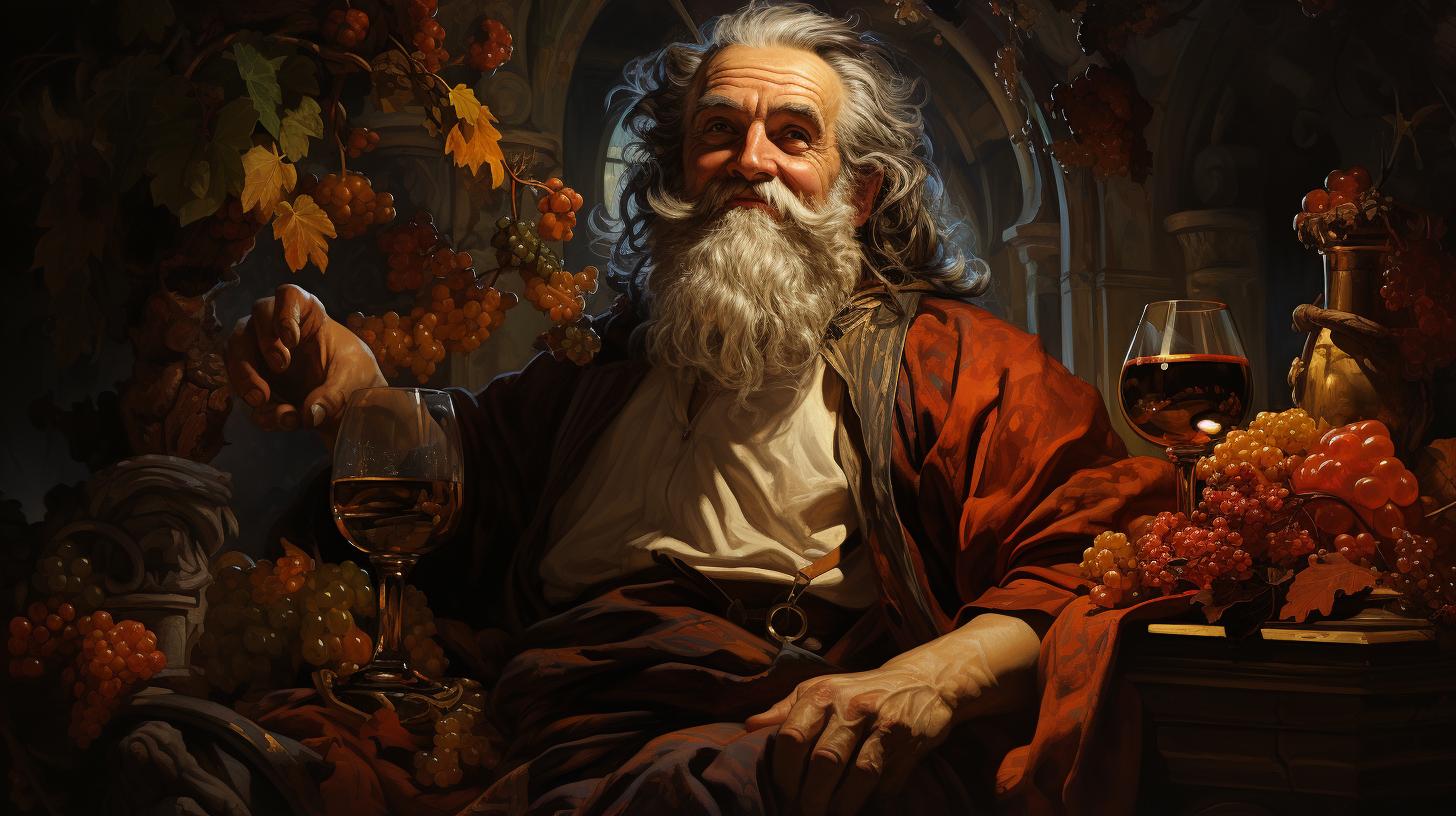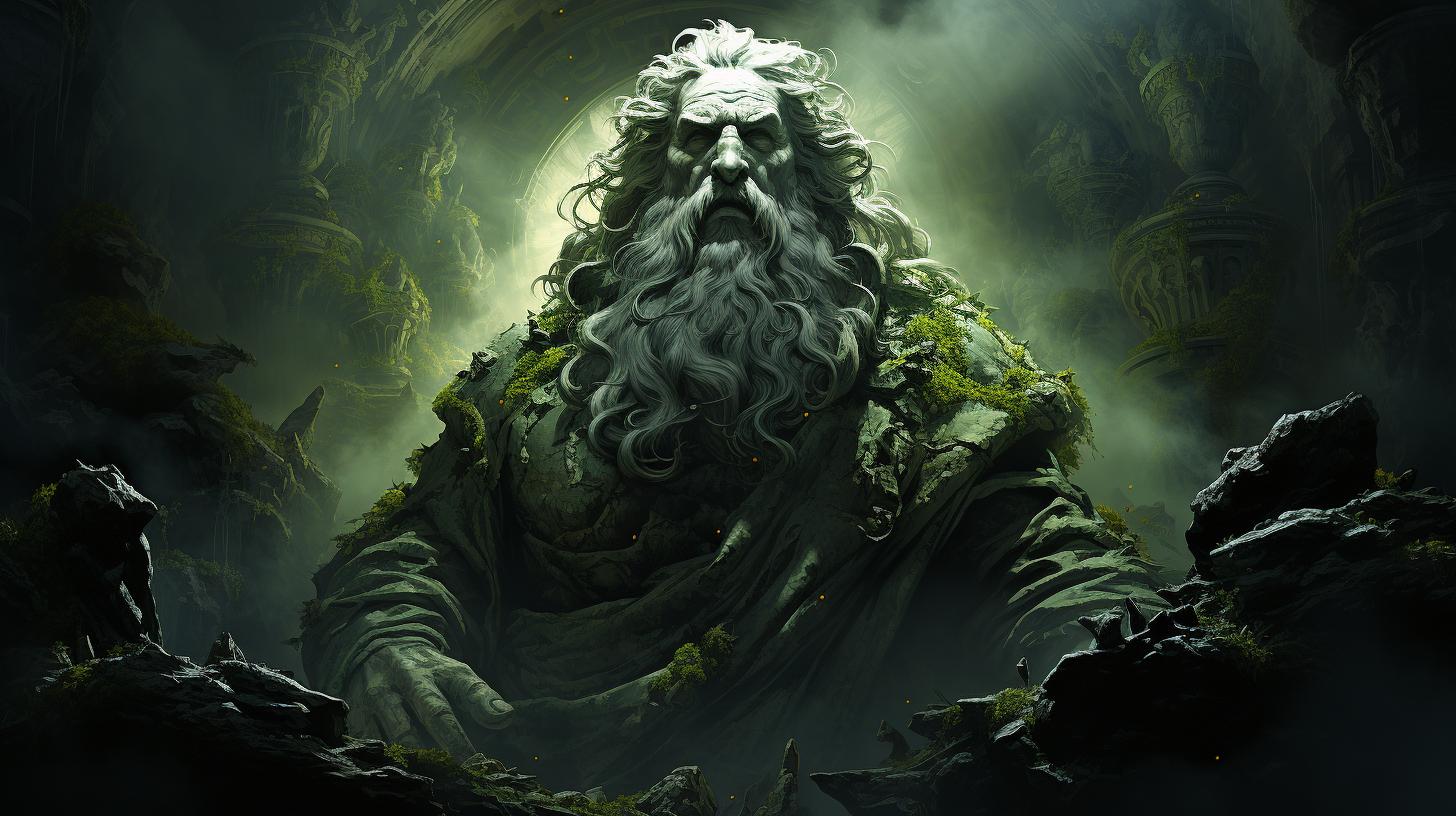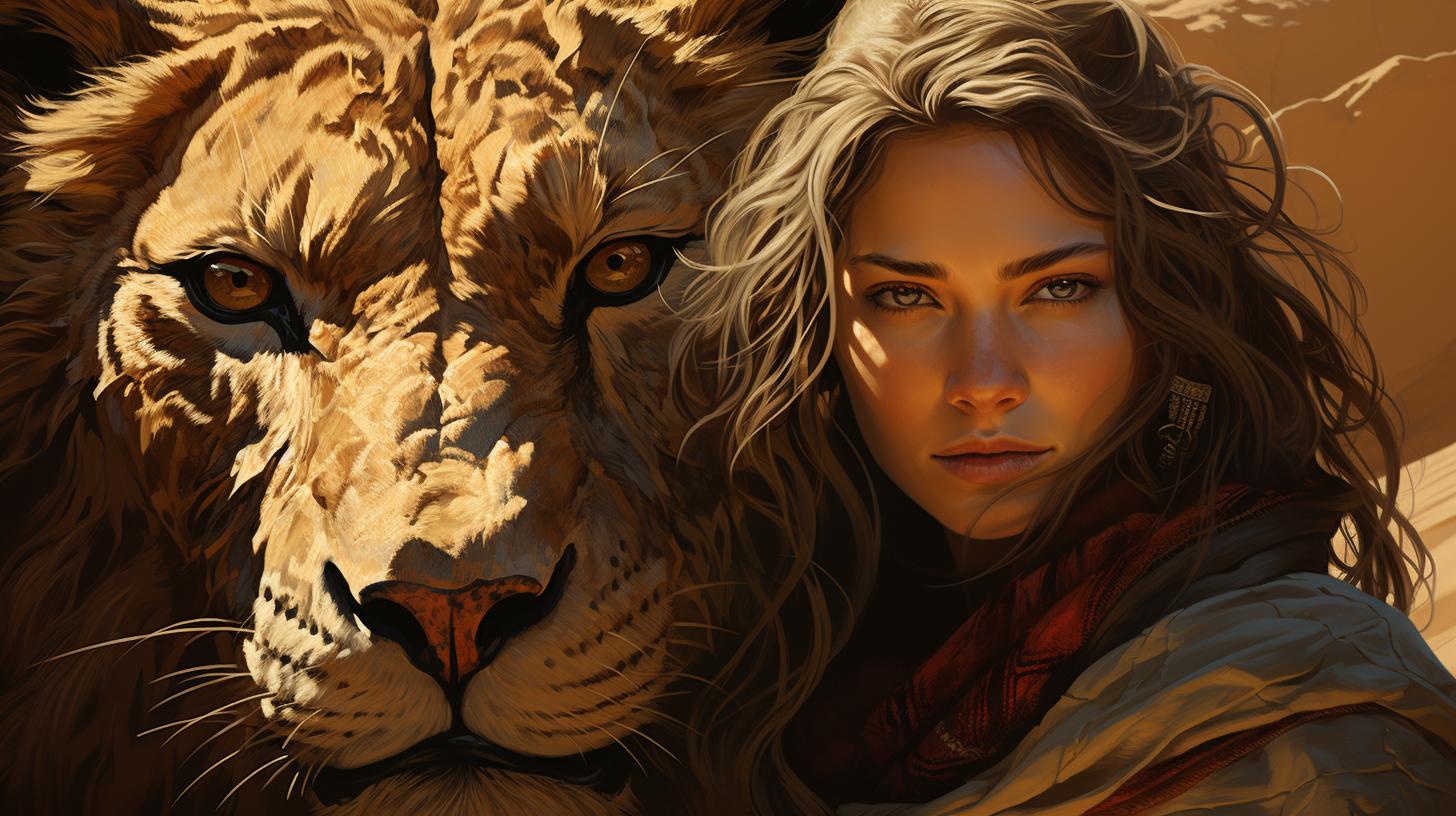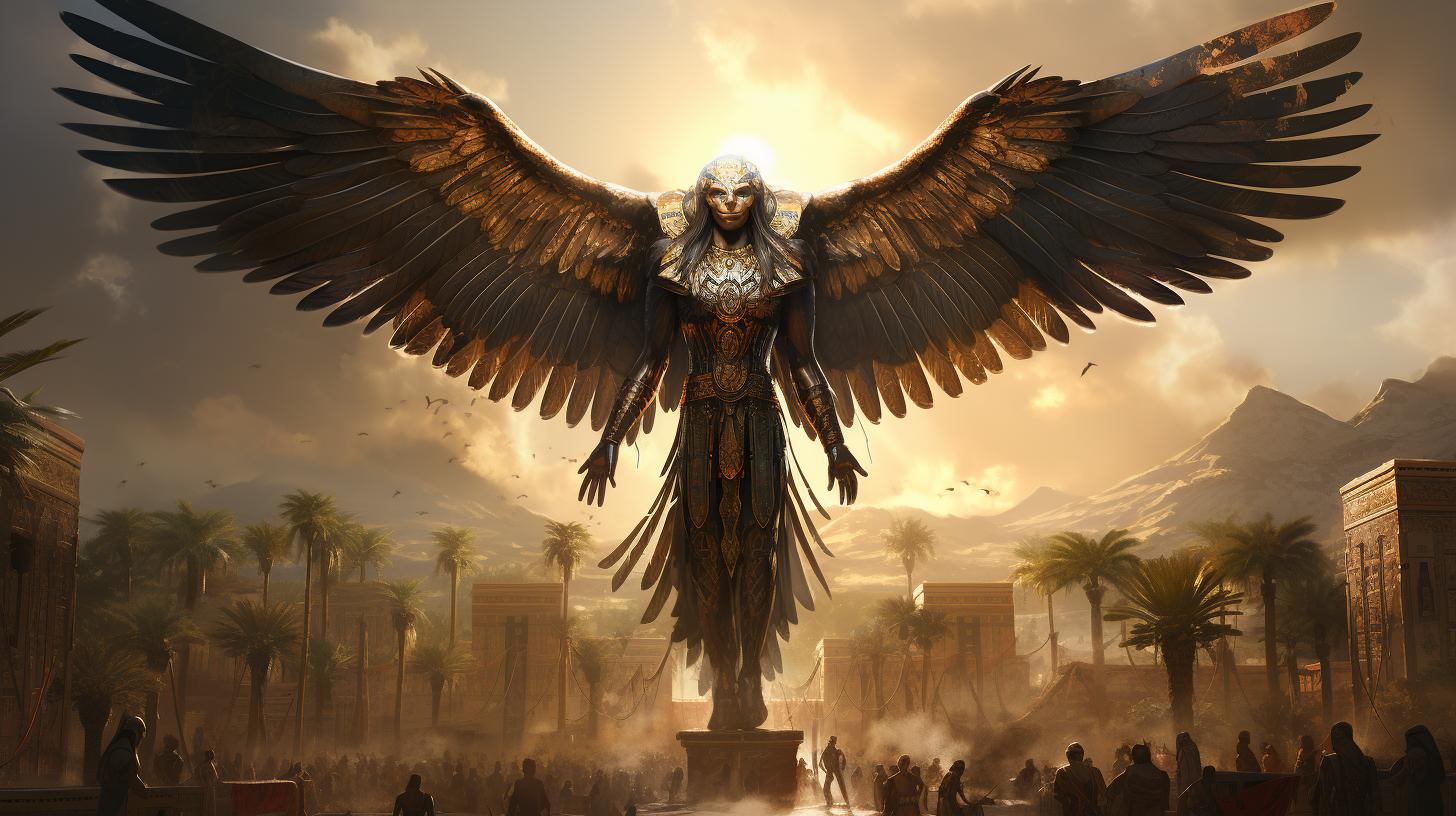Khonsu God of the Moon: The Mythology and Significance in Ancient Egyptian Culture
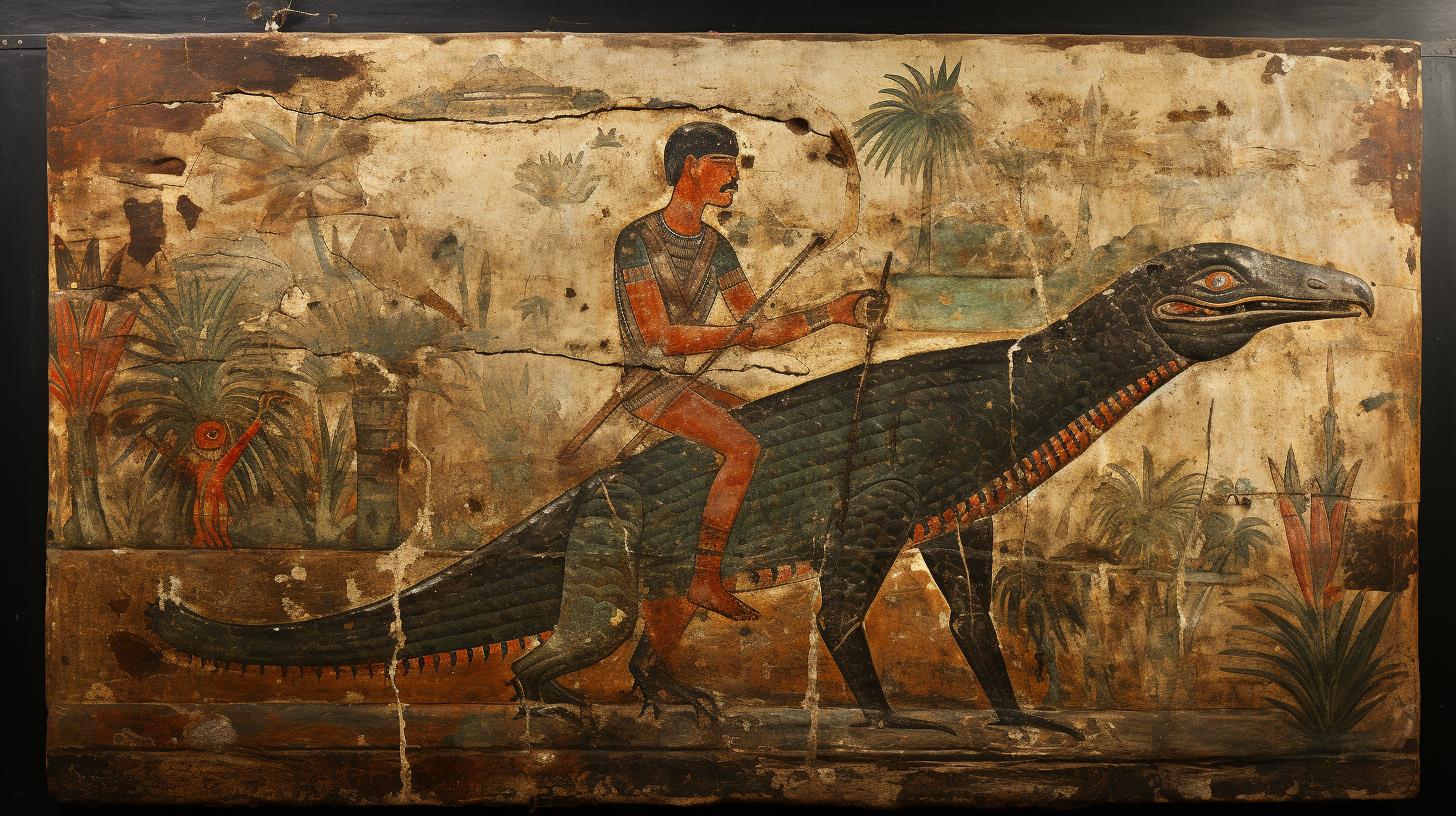
Khonsu, an Egyptian deity, was worshipped as the god of the moon, also known as the Egyptian god of the moon. He was considered the son of Amon and Mut, and was associated with baboons, fertility, and healing.
Khonsu was a part of a triad with Amun and Mut, with a major temple built for him in Thebes. Known as the moon god of Egypt, his symbol, often a crescent moon, signified his role and powers over the lunar cycle, influencing the fertility of both land and women.
His depictions varied from a young mummiform man with a full lunar disc atop his head, symbolizing his dominion as the god of the moon in Egypt, to a falcon-headed man playing games or riding on the back of a crocodile.
This article explores the mythology, symbology, including the Khonsu symbol or Khonshu symbol, worship, and legacy of Khonsu, shedding light on his powers and the significance of the moon in ancient Egyptian culture.
Khonsu in Ancient Egyptian Mythology
Khonsu, an ancient Egyptian deity, was worshipped as the god of the moon. His mythology is significant to understanding the ancient Egyptian religion and the role of religious practices in their culture.
The story of Khonsu, or Khonsu’s story, encompasses his journey through the night sky, illustrating the changing phases of the moon and its impact on the natural world.
In this section, we will discuss the origins and associations of Khonsu, his role in the ancient Egyptian pantheon, including who is the Egyptian god of the moon, and his temple in Thebes.
Khonsu’s Origins and Associations
Khonsu is considered the offspring of Amon and Mut and was worshipped from at least the Fifth Dynasty of Egypt.
The god Khonsu is believed to have originated from a fertility deity of the same name, meaning “traveller,” “wanderer,” or “wayfarer.” This etymology, or Khonsu meaning, underscores his role as a divine wanderer in the night sky, moving across the heavens and through the underworld.
Because of his connections to the moon and fertility, Khonsu was often paired with several goddesses, including Hathor, Isis, and Selket. The Khonsu animal, often depicted alongside him in art and mythology, varies but includes the baboon and falcon, animals that symbolized specific aspects of his divine attributes and powers.
Khonsu’s Role in the Ancient Egyptian Pantheon
Khonsu’s position in the ancient Egyptian pantheon changed over time, but he was often associated with control over the moon and its phases. Known as the Egypt moon god, his importance surged during the New Kingdom period when he became part of the Theban triad, composed of Amon, Mut, and Khonsu, embodying the god of the moon in Egyptian mythology.
The Theban triad represented creation, birth, and rebirth, with Amon as the creator, Mut as the mother, and Khonsu as the divine child. Khonsu, or Konshu god, played a crucial role in this celestial narrative, his name meaning “traveller,” highlighting his journey across the night sky.
Khonsu was also associated with other gods, including Thoth and Ra. Despite common comparisons, like Khonshu vs Thoth, each held distinct domains within Egyptian theology; Thoth as the deity of wisdom and writing, and Khonsu ruling over the moon.
He was sometimes depicted as the protector of the common people, a role prominently featured at Khonsu’s temple in Thebes, where people sought his protection and healing powers, especially against dangerous illnesses.
Khonsu’s Temple in Thebes
The temple of Khonsu, located in Thebes, stood as one of the most significant religious establishments in ancient Egypt. Built during the reign of Ramesses III, this temple was dedicated to the worship of Khonsu, the Egyptian moon god Khonshu.
It showcased the egyptian god Khonsu symbol, marking his divine essence and powers.
Situated to the south of the Temple of Amon, Khonsu’s temple is distinguished by its unique design and a procession path that connected the two temples, illustrating the tight bond between Khonsu and Amon within the pantheon.
As a center of cultic activity, the temple was staffed by priests who performed rituals for those seeking Khonsu’s aid. It likely housed various supernatural objects, including magical wands and amulets, used in healing and divination practices, attesting to the wide-ranging powers attributed to Khonsu in egyptian mythology.
- Khonsu, considered the offspring of Amon and Mut, embodies the narrative of a “traveller,” highlighting his significance as a deity who journeys across the night sky.
- Originally associated with the wheat harvest and farming, Khonsu later became revered for his connections to lunar magic, fertility, and healing, illustrating the evolution of his worship.
- Despite the evolving nature of his worship, Khonsu’s association with the moon and its phases remained a constant, underscoring his key role in Egyptian mythology.
- The temple of Khonsu in Thebes stands as a testament to his enduring legacy and importance within the ancient Egyptian religious landscape.
Khonsu the Moon God
As a pivotal deity in ancient Egyptian mythology, Khonsu’s worship was widespread throughout Egypt.
He was often depicted in various forms, reflecting the multifaceted nature of his divine aspects and powers.
Depictions of Khonsu as a Lunar Deity
- Khonsu, the Egypt god of the moon, was often represented as a youthful figure wearing a lunar disk on his head, symbolizing his dominion over the moon and its cycles.
- He was sometimes depicted with a falcon head or a side lock of hair, indicating his royal and divine status within Egyptian mythology.
- In one of his forms, Khonsu appeared as a mummified man with a full lunar disc, embodying protection and regeneration.
Khonsu’s Symbology and Iconography
- Kha, the lunar crescent, was a popular symbol associated with Khonsu, representing his aspects as the khonsu god of the moon.
- The god was often shown holding a crook and flail, which represented his power over life and fertility, and occasionally, a staff (Khonsu staff), indicating his authority.
- Khonsu was also linked with baboons, which were seen as sacred animals in ancient Egyptian culture, and their appearance at dawn was believed to herald his presence.
Relationships between Khonsu and Other Lunar Deities
- Khonsu was closely associated with Thoth, the god of wisdom and knowledge, who was also linked to the moon, illustrating the interconnected nature of moon deities in Egyptian mythology.
- He was also sometimes identified with Horus, the sky god who was also associated with the moon and the sun, showing the fluid identity of gods within the pantheon.
- Khonsu’s relationship with other lunar deities varied in different periods of ancient Egyptian history, reflecting the evolving understanding of his character and powers.
Khonsu was a multifaceted deity with complex iconography and symbology, embodying various aspects of the moon god in Egypt.
His role as a lunar god was reflected in various aspects of ancient Egyptian culture and religion, from temple worship to personal devotion. His legend as a violent and cannibalistic deity also contributed to his enigmatic character in ancient times, highlighting the dual nature of his influence, from the nurturing light of the moon to the feared aggressor.
Khonsu the Cannibal
Khonsu was associated with fertility and healing, but also had a darker side. In ancient Egyptian mythology, he was sometimes depicted as a cannibalistic deity who would eat the gods and goddesses, a testament to his unpredictable and formidable nature.
This section explores the legend of Khonsu’s cannibalism, interpretations of his violent nature, and his depictions as a violent deity, providing insights into the complexity of his character and his significance within the pantheon as not just a god of the moon but a powerful figure with both benevolent and fearsome aspects.
The Legend of Khonsu’s Cannibalism
According to Egyptian mythology, Khonsu, the moon egyptian god, was once an angry and dangerous deity who threatened to consume the other deities. In a pivotal event, the god Thoth, closely aligned with Khonsu in Egyptian mythology as Khonsu and Thoth, impersonated Khonsu’s father, Amon, and offered himself to be eaten instead.
Khonsu accepted the sacrifice, but was later tricked into spitting out Thoth. This legend, highlighting the intricate relationships among deities like Khonshu in Egyptian mythology, is often portrayed in ancient Egyptian art, showcasing the dynamic between Khonsu and Thoth.
Interpretations of Khonsu’s Cannibalistic Nature
Some scholars believe that Khonsu’s cannibalism was a metaphor for the cycle of life and death. In this interpretation, Khonsu represents the destructive force that must be overcome in order for new life to emerge, embodying both the creator and destroyer aspects of the moon god egyptian mythology.
Others see the story as a symbol for the importance of sacrifice in ancient Egyptian religion, with Thoth sacrificing himself to protect the other gods and goddesses from Khonsu’s wrath. This narrative emphasizes the ancient egypt moon god’s complex nature and the multifaceted interpretations of his actions and symbolism, such as the eye of Khonsu, which signifies his watchful and protective gaze.
Depictions of Khonsu as a Violent Deity
Khonsu was not always depicted as a gentle or benevolent deity. Many ancient Egyptian texts and artistic depictions show him as a violent and dangerous god who consumed other deities. Some experts believe that this was a way of showing Khonsu’s power and ability to protect the common people, reflecting on what does Khonsu mean and his role as a protector through aggression.
His violent nature may have also been associated with the destructive power of the moon, underscoring the dual nature of Khonsu’s influence in ancient Egyptian culture.
- Khonsu was often depicted with a uraeus, the symbol of khonsu, signifying royal power and the authority to punish enemies, and sometimes, the symbol of Khonsu, reinforcing his divine authority.
- Some depictions show Khonsu holding a knife or other weapon, further reinforcing his violent nature, while also highlighting Khonsu abilities for defense and protection.
- In one representation, Khonsu is shown with a lion’s head, representing his strength and power, and illustrating the ancient Egyptian god Khonsu’s fierce aspect.
- Other depictions show Khonsu playing senet, a popular Egyptian game that was believed to symbolize the struggle between good and evil, possibly alluding to the balance Khonsu maintains between his nurturing and destructive powers.
Despite his violent tendencies, Khonsu, the Egyptian god of the moon, was still respected and worshipped for his role as a protector and healer.
His ability to ward off evil spirits and to influence the health and fertility of both people and crops made him a central figure in Egyptian religious life.
His complex nature and significance within ancient Egyptian mythology make him a fascinating figure to study and explore.
Known as the god of the moon in Egypt, Khonsu’s influence extended over various aspects of life, embodying the dual nature of light and darkness.
Worship of Khonsu
Khonsu was a widely worshipped god in ancient Egypt. His followers included both common people and pharaohs, who saw him as a powerful defender against evil spirits and as a god of new beginnings.
The Egyptian moon deity’s temples and shrines were places of refuge and hope for many.
His worship practices were spread across the kingdom, with Khonsu temples and shrines existing in many cities, showcasing the widespread reverence for the moon god in Egyptian society.
The Practices and Rituals of Khonsu Worship
Worship of Khonsu involved various rituals and offerings to the deity, reflecting his esteemed position in the pantheon of Egyptian gods. Some of the most common practices included:
- Offerings of food and drink for Khonsu to consume or enjoy in his temple.
These could range from simple offerings of bread and beer, symbolic of basic sustenance, to more elaborate feasts, reflecting the wealth and devotion of his worshippers.
- Incense burning and libations to purify the temple and honor the god.
These acts created a sacred space for worship and were an integral part of ceremonies dedicated to Khonsu.
- Prayers and chants that praised Khonsu and asked for his protection or blessings.
These were often led by priests or other religious officials, utilizing specific phrases and hymns to invoke Khonsu’s power and favor.
- Animal sacrifices, which were sometimes practiced in more extreme forms of worship.
These sacrifices, typically reserved for special occasions such as the coronation of a new pharaoh or other significant events, were believed to appease Khonsu and secure his blessings for the people and the land.
Khonsu’s Place in Egyptian Temples
In the grand architecture of Egyptian temples, Khonsu was often depicted alongside other major deities, emphasizing his importance within the pantheon.
The Egyptian god Khonsu’s symbol, prominently featured in his temples, served as a powerful amulet against darkness and evil. His stories, including the tales of his powers and myths, were inscribed on temple walls, educating devotees about his virtues and the historical context of his worship.
Khonsu was typically worshiped in temples dedicated to him, many of which were located in the city of Thebes.
These temples were often lavish and well-maintained, with a staff of priests and other religious officials overseeing their care.
The worship and veneration of Khonsu, the Egypt god of the moon, highlighted his significant role within ancient Egyptian religion.
Inside these temples, Khonsu’s image was prominently displayed, often alongside other deities who were associated with him.
Khonsu’s appearance, usually depicted with a moon disc above his head, symbolized his connection to the lunar cycle. Some of the most common elements of Khonsu temples included:
- Statues and reliefs of Khonsu, often depicting him in various manifestations, from a youthful figure to a mummified man, showcasing what Khonsu looked like across different periods and regions.
- Shrines and altars for offerings and sacrifices, dedicated to honoring Khonsu and seeking his protection and blessings.
- Rooms for priests and other officials to conduct rituals and ceremonies, which were vital for maintaining the favor of this influential deity.
- Depictions of Khonsu’s myths and legends, which were often used as the basis for prayers and other devotional practices, telling the stories of his deeds, powers, and the significance of his role as a moon deity in Egyptian mythology.
How Khonsu was Worshipped Across the Kingdom
Worship of Khonsu was not limited to his temples, however.
Devotees often carried small statues or amulets of the god as a form of personal protection, and Khonsu’s image was sometimes incorporated into other religious practices. This highlighted his widespread reverence and the deep personal connection many felt with Khonsu, god of the moon in Egyptian mythology.
Khonsu was also often associated with other deities in the Egyptian pantheon, such as Amun and Ra, and was often worshiped alongside these gods in larger festivals and ceremonies. His parents, Amon and Mut, further connect him to a divine lineage, enriching the complexity of his character and worship.
Overall, Khonsu’s popularity and significance in ancient Egyptian culture cannot be overstated, and his worship practices were an important part of religious life for many centuries.
The Complex Legacy of Khonsu
Khonsu, the ancient Egyptian god of the moon, was an important deity in the New Kingdom period, and his legacy continues to this day.
This section explores the different ways in which Khonsu has been influential throughout history, from his role in the pantheon as the egyptian moon deity to the continued interest in his mythology and symbolism.
Khonsu’s Relevance in New Kingdom Egypt
During the New Kingdom period, Khonsu was an important deity in the Egyptian pantheon. He was worshipped by both royalty and commoners, and his major temple in Thebes was one of the most important religious sites in all of Egypt.
His stories, such as his powers to heal and protect, underscored his multifaceted nature as both a nurturing and powerful entity within Egyptian khonshu mythology.
As the god of the moon, Khonsu was associated with fertility, healing, and protection.
He was also closely linked to other important deities such as Amun and Mut.
Khonsu’s relevance during the New Kingdom period can be seen in many different areas of Egyptian culture.
For example, he was often depicted in tomb paintings and other forms of art.
He was also mentioned in many texts from this time period, including the famous Book of the Dead.
Khonsu’s Representation in Ancient Egyptian Literature
Khonsu’s legacy can also be seen in ancient Egyptian literature. He was often mentioned in myths and legends, and his cannibalistic nature was a particularly popular theme. One of the most famous stories involving Khonsu is the tale of the goddess Hathor and the Eye of Ra.
In this story, Khonsu helps to bring the Eye of Ra back to its rightful owner after it runs away in a fit of rage.
Other literary works that mention Khonsu include the Pyramid Texts, the Coffin Texts, and the aforementioned Book of the Dead.
In these texts, Khonsu is often portrayed as a powerful and important deity, capable of both great violence and great benevolence.
Khonsu’s Place in Modern Interpretations of Ancient Egypt
Finally, Khonsu’s legacy can be seen in modern interpretations of ancient Egypt. Many people today are fascinated by the mythology and symbolism of the ancient Egyptians, and Khonsu is often featured in popular culture.
For example, he is a character in the famous comic book series Moon Knight, and he has appeared in several movies and television shows.
Khonsu’s place in modern interpretations of ancient Egypt is also apparent in the many books, articles, and websites devoted to the subject.
These resources often explore Khonsu’s role in ancient Egyptian culture, as well as his significance in modern times.
- Khonsu’s relevance in New Kingdom Egypt is reflected in the many temples and tombs built in his honor, highlighting his importance as the god of the moon in ancient Egypt.
His temples served not only as places of worship but also as cultural centers where the myths and stories of Khonsu, or Dewa Khonsu as known in some interpretations, were shared and preserved.
- Khonsu’s cannibalistic nature is a popular theme in ancient Egyptian literature, especially in myths and legends.
This aspect of Khonsu Egyptian mythology illustrates the complex character of the deity, embodying both creation and destruction, which fascinated scholars and believers alike.
- Khonsu’s legacy can be seen in modern interpretations of ancient Egypt, including popular culture and scholarly works.
The Egyptian moon god, known for his symbols such as the crescent moon and the Eye of Khonsu, continues to influence artistic and academic explorations of Egyptian deities.
Khonsu in Popular Culture
Khonsu, the ancient Egyptian moon god, continues to captivate popular culture in various forms.
From comics to movies, his portrayal in modern media often veers away from traditional Egyptian mythology. This section explores how Khonsu is depicted in popular culture and how it differs from his traditional representation, shedding light on the evolution of his character from ancient Egyptian god to a modern icon.
The Portrayal of Khonsu in Moon Knight
Moon Knight, the Marvel comic book series, features a character named Marc Spector who is brought back to life by Khonshu, the Moon God. The character dons a white costume with a crescent moon symbol, and as such, is tied to Khonsu’s mythology.
In the comics, Khonshu is not depicted as an actual deity, but as a personality disorder plaguing Spector. While the origin story is not entirely accurate to Khonsu Egyptian mythology, it has definitely put the spotlight on Khonsu, bringing him into mainstream pop culture.
This reinterpretation by Marvel Comics showcases Khonshu, or Khonsu, as a complex figure whose legacy extends beyond his origins in Egyptian khonshu mythology.
Khonshu: Marvel Comics’ take on Khonsu
Khonshu’s depiction in the Marvel comics is a far cry from traditional representations of Khonsu in ancient Egyptian mythology. Instead of being a benevolent deity associated with fertility and healing, Khonshu is often portrayed as a vengeful and manipulative deity who forces Marc Spector to do his bidding.
The change in fearfulness of Khonshu’s nature is not entirely surprising, as this kind of narrative is common when modern authors try to adapt ancient mythologies to appeal to a wider audience.
Despite these differences, such adaptations highlight the enduring fascination with Khonsu, the Egyptian moon god, and his role within the rich tapestry of ancient mythology.
Khonsu and Egyptian Mythology in the Media
- Khonsu was featured in the 2016 video game “Assassin’s Creed Origins,” where he was voiced by Egyptian actor and writer Ashraf Hamdi.
The game’s depiction of Khonsu emphasizes his role as what is the Egyptian god of the moon, highlighting his journey across the sky and his influence on time and the celestial bodies.
- In the popular TV show “Stargate SG-1”, there is an episode titled “The Sentinel”, where Khonsu is mentioned several times as the god of the moon and fertility and the protector of women and children.
This episode explores the cult of Khonsu, showcasing his role in driving away evil spirits and protecting the pharaoh and his people.
- Khonsu’s religious significance was also discussed in a 2021 episode of the podcast “Mythology with Dafydd and Charlotte.”
The episode delves into Khonsu’s association with Horus and his contribution to the creation myth, underscoring his importance in the pantheon of Egyptian gods and his connection to the Earth and its cycles.
Overall, Khonsu’s representation in popular culture is far different from traditional Egyptian mythology.
While his mythology has been changed and adapted over time, Khonsu remains a powerful and inspiring figure that continues to leave an impact on modern media and culture. His stories and attributes, such as his role in the “Beautiful Festival of the Valley” at Karnak Temple and his mentions in ancient texts like “The Book of the Dead” and “The Book of the Earth,” underscore his enduring legacy and the fascination he holds for audiences and scholars alike.
.











